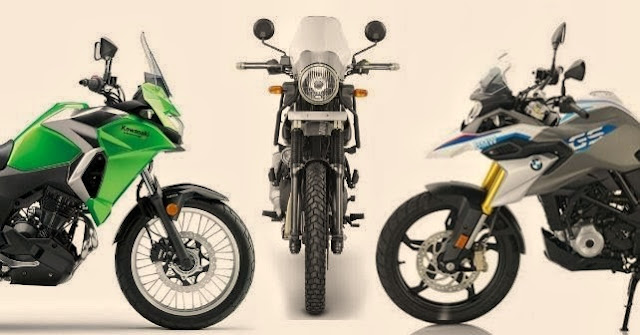Althoughnone of these motorcycles are valued comparatively, it's the body style that requires an examination.
These motorcycles have the capacity to handle whatever the street tosses at it, making them agreeable to go about in the city and in the meantime great visiting allies. The Royal Enfield Himalayan, the Kawasaki Versys X-300 and the all the more as of late propelled BMW G 310 GS are distinctive from numerous points of view, yet it's the idea of these motorcycles that unites them. In any case, before we get down to the minor points of interest, how about we investigate the cost.
The Royal Enfield Himalayan, valued at ₹1.72 lakh, is effectively the most reasonable of the parcel and by a colossal edge as well. Propelled at ₹3.49 lakh, the BMW G 310 GS possesses the second position, while the Kawasaki X-300, valued at ₹4.69 lakh, is the most costly of them every one of (all costs are ex-showroom Delhi.)
Motor:
While the Royal Enfield and the BMW offering accompanies a solitary barrel engine, the Kawasaki gets two chambers. As far as dislodging, in any case, the Royal Enfield's 411cc engine beat the graphs. Regardless of the high-relocation, the Himalayan makes minimal intensity of the three – only 24.5bhp. Strangely, the greater part of this power comes in at a more available 6,500rpm. Truth be told, the 32Nm of torque that it makes kicks in even lower at 4,500rpm. This should prove to be useful when riding rough terrain.
The BMW G 310 GS, then again, has indistinguishable engine from its stripped kin G 310 R and the TVS Apache RR310. This engine influences its top to intensity of 33bhp at an impressively higher 9,500rpm. It's most extreme torque of 28Nm kicks in at more than 7,500rpm. In the event that you surmise that the G 310 GS's engine is excessively peaky for an ADV, the Versys X-300 revs significantly higher. It acquires its heart from the supersport Ninja 300. What's more, despite the fact that at 38.7bhp it's the most great of the three, it is just conveyed at more than 11,000rpm. The Kawasaki additionally makes minimal torque of the three – only 25.7Nm. That being stated, the Japanese offering has the benefit of being the main twin-barrel offering in this correlation.
In contrast with the other two, the Kawasaki is additionally better prepared. It accompanies a help and shoe grasp – something that is absent from the other two.
Wheels and brakes:
To guarantee that riding off the street is second nature to the Himalayan, Royal Enfield has fitted it with 21-inch talked wheels in advance and 17-inch wheels at the back. Truth be told, the Kawasaki Versys 300 too has been fitted with talked wheels. Be that as it may, dissimilar to the Himalayan, the Versys 300 has been fitted with a 19-inch edge in advance and a 17-incher at the back. The BMW excessively gets an indistinguishable setup, making it impossible to the Kawasaki however manages with composite haggles tires. Brakes on the Himalayan and the G 310 GS are of indistinguishable size – a 300mm plate at the front and a 240mm circle at the back. The Kawasaki has been fitted with a 290mm circle in advance and a 220mm at the back. The Versys 300 and the G 310 GS both accompany double channel ABS, yet the Himalayan is yet to accompany ABS.
Every one of the three motorcycles are similarly coordinated on paper, particularly when you carry the cost into the condition. To think of an indisputable choice about which one is the best for somebody who needs to have an essence of street less undertakings, we should put them through a thorough test. Thus, stay tuned.







0 comentários